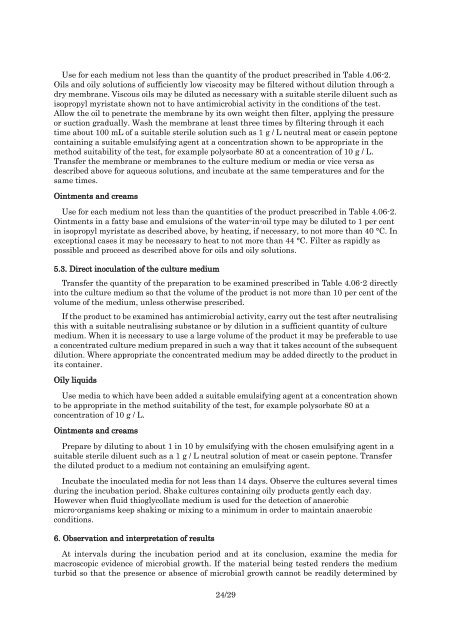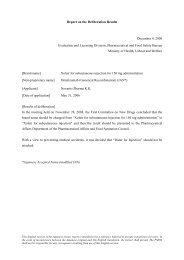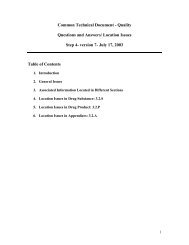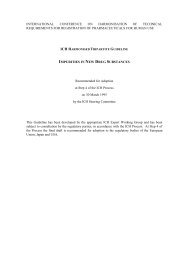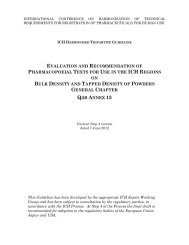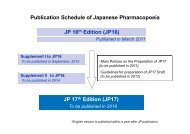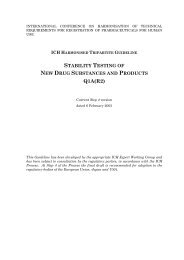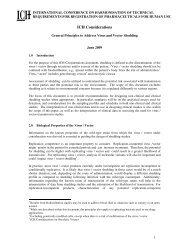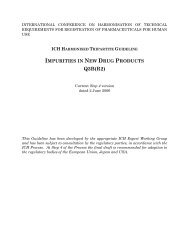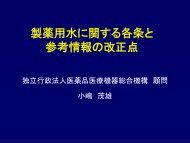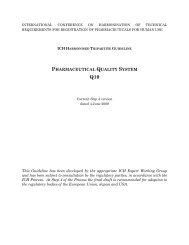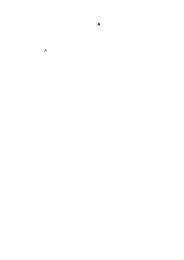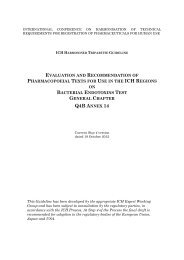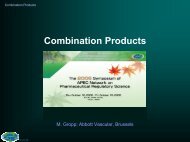4.05 Microbiological Examination of Non-sterile Products
4.05 Microbiological Examination of Non-sterile Products
4.05 Microbiological Examination of Non-sterile Products
- No tags were found...
Create successful ePaper yourself
Turn your PDF publications into a flip-book with our unique Google optimized e-Paper software.
Use for each medium not less than the quantity <strong>of</strong> the product prescribed in Table 4.06-2.Oils and oily solutions <strong>of</strong> sufficiently low viscosity may be filtered without dilution through adry membrane. Viscous oils may be diluted as necessary with a suitable <strong>sterile</strong> diluent such asisopropyl myristate shown not to have antimicrobial activity in the conditions <strong>of</strong> the test.Allow the oil to penetrate the membrane by its own weight then filter, applying the pressureor suction gradually. Wash the membrane at least three times by filtering through it eachtime about 100 mL <strong>of</strong> a suitable <strong>sterile</strong> solution such as 1 g / L neutral meat or casein peptonecontaining a suitable emulsifying agent at a concentration shown to be appropriate in themethod suitability <strong>of</strong> the test, for example polysorbate 80 at a concentration <strong>of</strong> 10 g / L.Transfer the membrane or membranes to the culture medium or media or vice versa asdescribed above for aqueous solutions, and incubate at the same temperatures and for thesame times.Ointments and creamsUse for each medium not less than the quantities <strong>of</strong> the product prescribed in Table 4.06-2.Ointments in a fatty base and emulsions <strong>of</strong> the water-in-oil type may be diluted to 1 per centin isopropyl myristate as described above, by heating, if necessary, to not more than 40 °C. Inexceptional cases it may be necessary to heat to not more than 44 °C. Filter as rapidly aspossible and proceed as described above for oils and oily solutions.5.3. Direct inoculation <strong>of</strong> the culture mediumTransfer the quantity <strong>of</strong> the preparation to be examined prescribed in Table 4.06-2 directlyinto the culture medium so that the volume <strong>of</strong> the product is not more than 10 per cent <strong>of</strong> thevolume <strong>of</strong> the medium, unless otherwise prescribed.If the product to be examined has antimicrobial activity, carry out the test after neutralisingthis with a suitable neutralising substance or by dilution in a sufficient quantity <strong>of</strong> culturemedium. When it is necessary to use a large volume <strong>of</strong> the product it may be preferable to usea concentrated culture medium prepared in such a way that it takes account <strong>of</strong> the subsequentdilution. Where appropriate the concentrated medium may be added directly to the product inits container.Oily liquidsUse media to which have been added a suitable emulsifying agent at a concentration shownto be appropriate in the method suitability <strong>of</strong> the test, for example polysorbate 80 at aconcentration <strong>of</strong> 10 g / L.Ointments and creamsPrepare by diluting to about 1 in 10 by emulsifying with the chosen emulsifying agent in asuitable <strong>sterile</strong> diluent such as a 1 g / L neutral solution <strong>of</strong> meat or casein peptone. Transferthe diluted product to a medium not containing an emulsifying agent.Incubate the inoculated media for not less than 14 days. Observe the cultures several timesduring the incubation period. Shake cultures containing oily products gently each day.However when fluid thioglycollate medium is used for the detection <strong>of</strong> anaerobicmicro-organisms keep shaking or mixing to a minimum in order to maintain anaerobicconditions.6. Observation and interpretation <strong>of</strong> resultsAt intervals during the incubation period and at its conclusion, examine the media formacroscopic evidence <strong>of</strong> microbial growth. If the material being tested renders the mediumturbid so that the presence or absence <strong>of</strong> microbial growth cannot be readily determined by24/29


